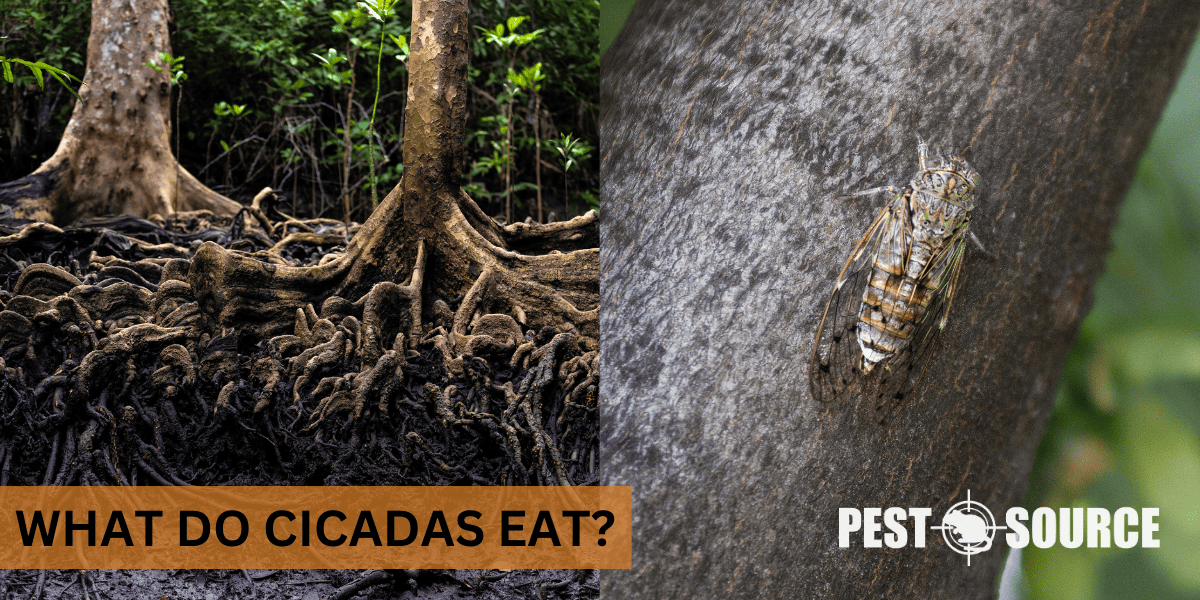Cicadas feed on the sap from the roots of trees and plants while they are underground in their nymph stage. As adults, they continue to consume plant sap but do not cause significant damage to the vegetation. Learn about the diet of cicadas and how it supports their long lifecycle underground.
POINTS
- Cicadas primarily feed on plant sap, with nymphs consuming root sap and adults feeding on sap from twigs and branches of deciduous hardwood trees like oak, ash, maple, and willow.
- The mouthparts of cicadas are specialized for sap-sucking, consisting of a long, straw-like structure called a proboscis, which allows them to pierce plant tissues and access the sap.
- Cicadas are attracted to warm environments with abundant food sources, particularly areas with a high density of trees that provide the necessary sap for their diet.
- While cicadas can cause some harm to plants through their egg-laying process, the overall environmental impact of cicadas is generally low, as they contribute to soil aeration and serve as a food source for many predators.
- Cicadas and locusts are distinct; cicadas have a minimal environmental impact and feed on sap, while locusts can cause significant agricultural damage by consuming leaves, flowers, and crops in large swarms.
Cicada Diet
Cicadas are fascinating insects known for their distinctive sound and periodic emergence from the ground. Understanding their diet is essential for appreciating their role in the ecosystem.
Basic Diet of Cicadas
Cicadas primarily feed on the sap from plants. This sap provides them with all the necessary nutrients they need to survive. They use their specialized mouthparts, known as a beak or proboscis, to pierce the plant tissue and access the sap.
Trees Cicadas Favor
Cicadas show a preference for certain trees, especially deciduous hardwood trees. They are particularly fond of oak, ash, maple, and willow trees. These trees provide an abundant source of sap that cicadas can easily access.
Nymphs vs. Adult Feeding Habits
- Underground Nymphs: Cicada nymphs live underground for most of their lives, where they feed on the sap from tree roots. This diet is rich in nutrients and supports their growth over several years.
- Above Ground Adults: Once they emerge and molt into adults, cicadas continue to feed on plant sap, but they switch to the accessible sap of twigs and branches.
Adult Cicadas and Captivity Diet
Adult cicadas do eat, but their feeding is less frequent compared to their nymph stage. In captivity, cicadas can be provided with branches from preferred trees to mimic their natural feeding habits.
Do Cicadas Have Mouths?
Cicadas do have mouths designed specifically for their sap-based diet. Their mouthparts consist of a long, straw-like structure capable of piercing plant tissues. This adaptation allows them to efficiently suck out the sap without causing extensive damage to the host plant.
What Attracts Cicadas?
Cicadas are attracted to environments that offer ample food sources and suitable conditions for their development. They seek out areas with a high density of trees that provide the sap they need. Warm temperatures and the availability of soft twigs for egg-laying also play a role in attracting cicadas.
Are Cicadas Harmful to Plants?
Cicadas can cause some harm to plants, but it is usually minimal. The primary concern is their egg-laying process, which involves slicing into twigs to deposit eggs. This can cause “flagging,” or wilting, of branches. However, healthy trees typically recover from this damage.
Cicada Diet: Cicadas Food and Nutrition Facts
To summarize, cicadas have a diet that is quite specialized and relatively consistent throughout their lifecycle. Here are some key nutritional facts about cicada diets:
- Sap as a Nutrient Source: The sap from trees provides cicadas with water, sugars, amino acids, and minerals necessary for their survival.
- Efficiency of Sap Consumption: Cicadas are adapted to extract and digest sap very efficiently, which compensates for the sap’s relatively low nutritional content compared to other food sources.
- Nutritional Value: While detailed nutritional analyses of tree sap consumed by cicadas are not typically available, it is known that the sap must fulfill all of their dietary needs, including energy production and protein synthesis, for the duration of their life cycle.
Cicadas have adapted to thrive on a sap-based diet, which supports their growth and development from nymph to adult. Their unique dietary habits contribute to their role in the ecosystem as both a consumer of plant resources and a food source for other species.
How Long Do Cicadas Live?
The life span of cicadas varies; adult cicadas, after emerging from the ground, live for several weeks to mate and lay eggs, but nymphs living underground can survive for several years, with periods ranging from 2 to 17 years depending on the species. The most well-known are periodical cicadas, which spend 13 or 17 years underground before surfacing for their brief adult phase.



